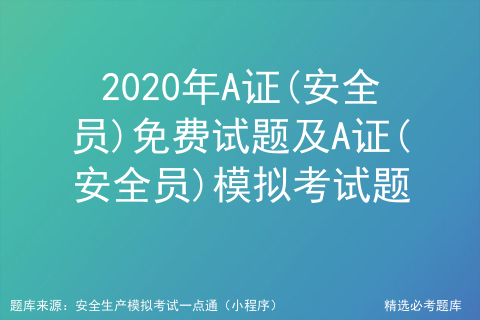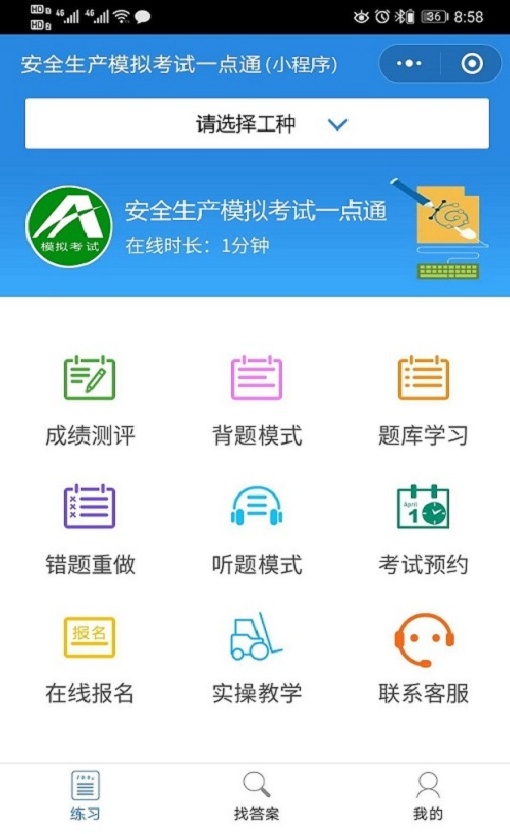本文共 4960 字,大约阅读时间需要 16 分钟。
题库来源:安全生产模拟考试一点通公众号小程序
2021年安全员-A证(安全员)考试APP为正在备考安全员-A证(安全员)操作证的学员准备的理论考试专题,每个月更新的安全员-A证(安全员)免费试题祝您顺利通过安全员-A证(安全员)考试。

1、【单选题】当采用扣件式钢管做支撑模板的立柱时,每根立柱底部应设置底座及垫板,垫板厚度不得小于( )mm( B )
A、30
B、50
C、60
D、100
2、【单选题】当塔式起重机的起重臂根部铰点高度超过( )时应配备风速仪。( C )
A、30m
B、40m
C、50m
D、60m
3、【单选题】当塔式起重机使用周期超过( )时,进行一次全面检查,合格后方可继续使用。( C )
A、一季度
B、半年
C、一年
D、两年
4、【单选题】当吊重超过最大起重量并小于最大起重量的110%时,( )应当动作,使塔机停止提升方向的运行。( D )
A、起重力矩限制器
B、变幅限制器
C、行程限制器
D、起重量限制器
5、【单选题】开挖深度( )及以上的基坑周边应按规范要求设置防护栏杆。( B )
A、1
B、2
C、3
D、4
6、【单选题】开始起吊时,应先将构件吊离地面( )mm后停止起吊,并检查起重机的稳定性、制动装置的可靠性、构件的平衡性和绑扎的牢固性等,待确认无误后,方可继续起吊。( B )
A、50~100
B、200~300
C、500~600
D、900~1000

7、【单选题】建筑施工扣件式钢管脚手架立杆接长除顶层顶步可采用搭接外,其余各层各步接头必须采用( )连接。( A )
A、对接扣件
B、旋转扣件
C、绑扎
D、直角扣件
8、【单选题】工作坑内,人员上下应设符合规定的和固定牢固的( )。( C )
A、安全带
B、安全网
C、安全梯
D、安全绳
9、【单选题】塔式起重机停用( )以上的,在复工前,应重新进行验收,合格后方可使用。( C )
A、1个月
B、3个月
C、6个月
D、12个月
10、【单选题】基坑支撑结构的拆除方式、拆除顺序应符合( )要求。( A )
A、专项施工方案
B、工序
C、施工现场环境
D、施工进度
11、【单选题】在特殊环境下,钢丝绳的纤维芯由于受潮而膨胀造成外层绳股受力不均衡绳股错位,当钢丝绳实际直径增加5%以上,钢丝绳应立即( )( B )
A、维修
B、报废
C、除锈
D、涂刷润滑剂
12、【单选题】单斗挖掘机的构造中,由动臂、斗杆、铲斗组成的是( )。( B )
A、发动机
B、工作装置
C、回转装置
D、行走装置
13、【单选题】分配箱与开关箱间的距离不应超过( )m,开关箱与用电设备间的距离不应超过( )m( )。( D )
A、15、3
B、15、10
C、15、30
D、30、3
14、【单选题】关于施工起重机械安装及拆卸作业,下列说法错误的是:( )。( C )
A、安装、拆卸施工起重机械和整体提升脚手架、模板等自升式架设设施,应当编制拆装方案、制定安全施工措施
B、安装、拆卸施工起重机械和整体提升脚手架、模板等自升式架设设施,应当由专业技术人员现场监督
C、施工起重机械和整体提升脚手架、模板等自升式架设设施安装完毕后,总包单位应当自检,出具自检合格证明,并向施工单位进行安全使用说明,办理验收手续并签字
D、垂直运输机械作业人员、安装拆卸工、爆破作业人员、起重信号工、登高架设作业人员等特种作业人员,必须按照国家有关规定经过专门的安全作业培训,并取得特种作业操作资格证书后,方可上岗作业
15、【单选题】依照《安全生产法》规定,生产经营单位的主要负责人和安全管理人员必须具备与本单位所从事的生产经营活动相应的( )和管理能力。( C )
A、生产经营
B、安全技术
C、安全生产知识
D、执业资格
16、【单选题】作业时( )将施焊把线绕在身上或搭在背上。( D )
A、不能
B、可以
C、一般
D、严禁
17、【单选题】以下哪项属于物的不安全状态( )。( A )
A、材料设备器具等堆放的不安全
B、分散注意力行为
C、不用个人防护用品
D、攀坐不安全位置
18、【单选题】人货两用施工升降机提升吊笼钢丝绳的安全系数不得小于( )。( D )
A、6
B、8
C、10
D、14
19、【单选题】临边作业的防护栏杆应由横杆、立杆及不低于( )mm高的挡脚板组成。( C )
A、100
B、150
C、180
D、200
20、【单选题】下列关于施工升降机使用叙述错误的是:( B )
A、当遇大雨、大雪、大雾、施工升降机顶部风速大于20m/s或导轨架、电缆表面结有冰层时,不得使用施工升降机。
B、必须使用行程限位开关作为停止运行的控制开关。
C、使用期间,使用单位应按使用说明书的要求对施工升降机定期进行保养。
D、在施工升降机基础周边水平距离5m以内,不得开挖井沟,不得堆放易燃易爆物品及其他杂物。
21、【单选题】( )是建筑施工企业所有安全规章制度的核心。( D )
A、安全检查制度
B、安全技术交底制度
C、安全教育制度
D、安全生产责任制度
22、【单选题】《建设工程安全生产管理条例》规定,施工单位的项目负责人应根据工程的特点组织制定安全施工措施,消除安全事故隐患,( )报告生产安全事故。( A )
A、及时、如实
B、调查清楚后
C、准时、真实
D、及时、全面
23、【单选题】《建设工程安全生产管理条例》规定,施工单位的主要负责人、项目负责人、专职安全生产管理人员应当经( )考核合格后方可任职。( B )
A、建设部
B、建设行政主管部门或者其他有关部门
C、安全生产综合管理部门
D、劳动和社会保障部门
24、【单选题】《建设工程安全生产管理条例》规定,施工单位应当设立安全生产管理机构,配备( )人员。( A )
A、专职安全生产管理
B、兼职安全生产管理
C、安全生产监理
D、专兼职安全生产检查
25、【单选题】《建设工程安全生产管理条例》规定,建设单位在编制工程( )时,应当确定建设工程安全作业环境及安全施工措施所需的费用。( C )
A、施工预算
B、施工方案
C、概算
D、决算
26、【单选题】超过一定规模危险性较大的分部分项工程专项方案经论证后需做重大修改的,施工单位应当按照论证报告修改,并( )专家进行论证。( B )
A、认定
B、重新组织
C、无需
D、放弃
27、【单选题】装载机前轮应与沟槽边缘保持不少于( )的安全距离,并放置挡木挡掩。( D )
A、5m
B、4m
C、3m
D、2m
28、【单选题】现浇钢筋混凝土梁、板,当跨度大于( )时,模板应起拱;当设计无具体要求时,起拱高度宜为全跨长度的1/1000~3/1000。( C )
A、2
B、3
C、4
D、5
29、【单选题】滑轮绳槽壁厚磨损量达原壁厚的( )应报废。( D )
A、50%
B、40%
C、30%
D、20%
30、【单选题】混凝土搅拌机料斗放在最低位置时,在料斗与地面之间应加( )。( A )
A、一层缓冲垫木
B、石子
C、水泥
D、砂石垫层
31、【单选题】消防车道的净宽和净空高度分别不应小于( )m。( D )
A、1
B、2
C、3
D、4
32、【单选题】浇筑高度2m以上的混凝土结构构件时,应设置( )( D )
A、塑料模壳
B、扶梯
C、马蹬
D、脚手架或操作平台
33、【单选题】桩基作业结束后,应将桩锤落下,切断( )和电路开关、停机制动后人可离开。( A )
A、电源
B、水源
C、气源
D、油路
34、【单选题】根据施工现场消防安全责任制度的要求,施工现场应建立义务消防队,人数不少于施工总人员的( )( B )
A、1%
B、10%
C、50%
D、75%
35、【单选题】根据建设部的有关规定,施工单位( )的工人,必须接受三级安全培训教育,经考核合格后,方能上岗。( B )
A、转岗
B、新入场
C、变换工种
D、从事特种作业
36、【单选题】根据《建设工程安全生产管理条例》规定,施工单位应当在施工现场建立消防安全责任制度,确定( )。( D )
A、安全责任人
B、保卫责任人
C、义务消防队
D、消防安全责任人
37、【单选题】根据《建筑企业职工安全培训教育暂行规定》的要求,企业法人代表、项目经理教育和培训的时( )。( B )
A、5学时
B、30学时
C、60学时
D、90学时
38、【单选题】根据《安全色》规定,安全色分为红、黄、蓝、绿四种颜色,分别表示( )( C )
A、禁止、指令、警告和提示
B、指令、禁止、警告和提示
C、禁止、警告、指令和提示
D、提示、禁止、警告和指令
39、【单选题】架空线路的线间距不得小于( ),靠近电杆的两导线的间距不得小于( )。( D )
A、1.5m;0.5m
B、0.5m;1.5m
C、0.5m;0.3m
D、0.3m;0.5m
40、【单选题】施工现场开挖沟槽边缘与外电埋地电缆沟槽边缘之间的距离不得小于( )。( A )
A、0.5m
B、1m
C、1.5m
D、2m
41、【单选题】施工升降机操作按扭中,( )必须采用非自动复位型( D )
A、上升按钮
B、下降按钮
C、停止按钮
D、急停按钮
42、【单选题】按照规定,开挖深度超过( )的基坑,槽的土方开挖工程应当编制专项施工方案。( C )
A、3米(含3米)
B、5米
C、5米(含5米)
D、8米
43、【多选题】脚手架及其地基基础应在下列哪些情况下进行检查与验收( )。( ABD )
A、基础完工后及脚手架搭设前
B、作业层上施加荷载前
C、每搭设完3~5m高度后
D、遇有六级大风与大雨后;寒冷地区开冻后
44、【多选题】生产经营单位的从业人员有权了解其作业场所和工作岗位存在的( )。( AD )
A、危险因素
B、风险
C、特点
D、防范措施
45、【多选题】混凝土搅拌机作业中不得( )。( ACD )
A、加料
B、加水
C、加油
D、检修
46、【多选题】梁式或桁架式支架的构造与安装应符合下列规定:( )。( ABCD )
A、采用伸缩式桁架时,其搭接长度不得小于500mm,上下弦连接销钉规格、数量应按设计规定,并应采用不少于2个U形卡或钢销钉销紧,2个U形卡距或销距不得小于400mm
B、安装的梁式或桁架式支架的间距设置应与模板设计图一致
C、支承梁式或桁架式支架的建筑结构应具有足够强度,否则,应另设立柱支撑
D、若桁架采用多榀成组排放,在下弦折角处必须加设水平撑
E、支承梁式或桁架式支架的建筑结构必须另设立柱支撑
47、【多选题】梁式或桁架式支架的构造与安装应符合下列规定( )。( ABCD )
A、采用伸缩式桁架时,其搭接长度不得小于500mm,上下弦连接销钉规格、数量应按设计规定,并应采用不少于2个U形卡或钢销钉销紧,2个U形卡距或销距不得小于400mm
B、安装的梁式或桁架式支架的间距设置应与模板设计图一致
C、支承梁式或桁架式支架的建筑结构应具有足够强度,否则,应另设立柱支撑
D、若桁架采用多榀成组排放,在下弦折角处必须加设水平撑
48、【多选题】桩工机械使用的( )等材料及标准件应有制造厂签发的出厂产品合格证、质量保证书、技术性能参数等文件。( ABCD )
A、钢丝绳
B、电缆
C、夹头
D、螺栓
49、【多选题】根据建筑施工临时支撑结构技术规范要求,支撑结构的地基应符合下列哪些规定( )。( ABC )
A、搭设场地应坚实、平整,并应有排水措施
B、支撑在地基土上的立杆下应设具有足够强度和支撑面积的垫板
C、混凝土结构层上宜设可调底座或垫板
D、对承载力不足的地基土,可增设垫板数量
50、【多选题】推土机铲刀操纵控制阀应准确有效地控制铲刀处于( )等状态。( ABC )
A、保持
B、提升
C、下降
D、回转
以上是2021年安全员-A证(安全员)考试APP及安全员-A证(安全员)免费试题。支持全国各地区精准安全员-A证考试试题,支持安全资格证,特种作业操作证,职业技能鉴定等工种题库练习。
转载地址:http://tsfp.baihongyu.com/